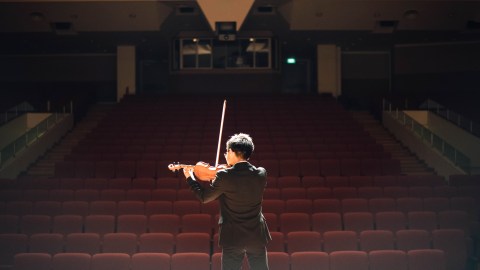Musicians and their audiences show synchronized patterns of brain activity

Photo by chuttersnap on Unsplash
When a musician is playing a piece, and the audience is enjoying it, they can develop physical synchronies. Both might tap their feet, sway their bodies, or clap their hands.
“Through music, the producer and the perceiver connect emotionally and behaviourally,” note the authors of a new paper, published in NeuroImage. And now this team, led by Yingying Hou at East China Normal University, has uncovered a connection right down at the neural level. The team has observed “inter-brain coherence” (IBC) — a synchronisation in brain activity — between a musician and the audience. What’s more, the strength of this coherence could be used to predict how much the audience enjoyed a piece.
The team used a technique called near-infrared spectroscopy to monitor the brain activity of a professional violinist while he was videoed playing a series of 12 brief, classical pieces. They then used the same technique (which involves shining beams of light through the skull, to monitor changes in blood flow) on 16 women while they watched the video, and listened to all of these pieces. (Because gender differences in inter-brain synchronisation have previously been observed, only women were recruited as listeners.)
The violinist had been instructed to look directly at the camera and maintain a neutral expression while he played the pieces, which each lasted about 100 seconds. If he was enjoying one piece more than another, the team hoped this would not be obvious to the viewers. They were told to gaze at the violinist’s face while they listened. After each piece, they rated how much they liked it on a seven-point scale.
The data revealed inter-brain coherence between each of the listeners and the musician, for all of the violin pieces. That is, there were similar patterns of heightened activity in certain key regions of the brain while the violinist played and the other participants listened.
The key regions included the left temporal cortex (which is thought to focus on processing the rhythm of sound information), the right inferior frontal cortex and the postcentral cortices. These two latter regions have been highlighted as important hubs of a hypothesised mirror system that allows a sender and receiver to share brain representations. “In the present study, the frontoparietal mirror neuron system allows audiences to experience or comprehend the mind of the performer as if they were to ‘walk in another’s shoes’,” the researchers believe.
The team also produced an average IBC score for each piece of music, and compared these with the listeners’ averaged liking scores for each piece. They found clear correlations. The more popular pieces were marked by stronger inter-brain coherence in the left temporal cortex between the audience as a whole and the performer.
The team also reported that the link between level of coherence and popularity only developed during the second half of each piece. This could be because there are two stages to music appreciation, they suggest. The first stage involves recognising rhythms, and identifying the potential musical structure of a piece. During the next stage, the listener develops aesthetic judgements and experiences emotional resonance, and generates stronger predictions about the sounds that ‘should’ follow. “If the expectation matches the incoming information, the musical performance will be experienced as pleasant,” the team thinks.
More work will be needed to explain why the coherence-liking effect only emerged at a group level, and to explore whether the results obtained here will also apply to other types of musical instrument, and other genres. The team also note that the near-infrared technique only allowed them to look at blood flow in the cortex, not other deeper areas that might be involved in the response to music production and perception, too, such as limbic structures. Also, by design, this study only involved women. Whether men will respond in the same way is unknown.
Still, it’s fascinating research. “This study expands our understanding of music appreciation,” the researchers write, adding: “The results can potentially be applied to the development of brain indices for predicting public attitudes towards various musical performances.”
Emma Young (@EmmaELYoung) is a staff writer at BPS Research Digest
Reprinted with permission of The British Psychological Society. Read the original article.





